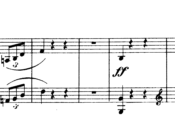Analysis
Contents
First Movement (Allegro Moderato)
Form: Sonata Form. F Major.
EXPOSITION (Bars 1-47):
Bars 1-13: First Subject. Tonic key, F Major. Ends with a Perfect Cadence.
Bars 13-21: Bridge Passage or Episode. Commences in Tonic key, moves to Relative minor, D minor (Bar 15), to conclude with Imperfect Cadence in Dominant key, C Major (Bar 21).
Bars 22-47: Second Subject. Dominant key, C Major. Touches Relative minor, D minor (Bar 27), C Major (Bar 28), C minor (Bar 30), C Major (Bar 34), to conclude with Perfect Cadence in that key (Bar 47).
Double Bar and Repeat.
DEVELOPMENT (Bars 48-87):
Commences with material of First Subject in Dominant key, C Major, moving though F Major (Bar 53), B flat Major (Bar 55), G minor (Bar 57), D minor (Bar 59), G minor (Bar 67), D minor (Bar 68). Material of Bridge Passage and concluding bars of the Exposition was used to bass through these keys. New Material enters (Bar 70) in D minor, modulating to G minor (Bar 79), then to Dominant key, C Major (Bar 82). The Development concludes with Perfect Cadence in Tonic key, F Major.
RECAPITULATION (Bars 87-129):
Bars 87-98: First Subject. Tonic key, F Major. Ends with Imperfect Cadence (Bar 98).
No Bridge Passage or Episode.
Bars 99-129: Second Subject. Tonic key, F Major. Trill on Dominant Pedal-point (C) appears at Bar 107. The movement concludes with Perfect Cadence in Tonic key, F Major.
Double Bar and Repeat.
Second Movement (Larghetto)
Form: Binary Form. F Minor.
PART I (Bars 1-20):
Commencing in Tonic key, F minor, passing through Relative Major, A flat Major (Bar 5), D flat Major (Bar 7), F minor (Bar 11), Dominant key, C minor (Bar 13), returning to Relative Major, A flat Major (Bar 15), to end with Perfect Cadence in that key.
Double Bar and Repeat.
PART II (Bars 21-39):
Commences with Material of Part I in Sub-dominant key, B flat minor, modulating to C minor (Bar 23), A flat Major (Bar 25), returning to Tonic key (Bar 26), concluding the Movement with Perfect Cadence in F minor.
Double Bar and Repeat.
Third Movement (Presto)
Form: Sonata Form. F Major.
EXPOSITION (Bars 1-53):
Bars 1-17: First Subject. Tonic key, F Major. Touches G minor (Bar 14) to end with Imperfect Cadence in F Major.
Bars 17-33: Bridge Passage or Episode. Commences in Dominant minor key, C minor, to move to the Dominant Major key, C Major (Bar 21) ending with Imperfect Cadence (Bars 28-33).
Bars 33-53: Second Subject. Dominant key, C Major. Touches Relative minor, D minor (Bar 38), returns to Dominant key, C Major (Bar 39), then D minor (Bar 42) to C Major (Bar 43), ending the Exposition with a Perfect Cadence.
Double Bar and Repeat.
DEVELOPMENT (Bars 54-95):
Commencing with new material in Supertonic minor key, G minor, Material of First Subject enters at Bar 61 and is used by Inversion in E flat Major (Bar 65), moving through F minor (Bar 70), C minor (Bar 72), G minor (Bar 74), D minor (Bar 76), leading to Tonic key, F Major (Bar 88), concluding with Imperfect Cadence (Bar 95) in Tonic key.
RECAPITULATION (Bars 95-149):
Bars 95.5-113: First Subject. Tonic key, F Major. Altered from Bar 101, when it modulates to B flat Major, then D minor (Bar 102); returning to Tonic key, F Major, with Dominant Pedal-point in Bass part (C) at Bar 107, to end with Perfect Cadence in Dominant key, C Major.
Bars 113-129: Bridge Passage or Episode. Different material to Bridge Passage in Exposition, it passes through B flat Major (Bar 118), G minor (Bar 119), C Major (Bar 123), to return to Tonic key, F Major (Bar 125), ending with Chord of the Dominant Seventh (Bars 125-129).
Bars 129-149: Second Subject. Tonic key, F Major, Touching Supertonic minor, G minor (Bars 134 and 142), returns to F Major (Bar 144) to end with Perfect Cadence.
Double Bar and Repeat.









